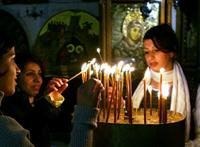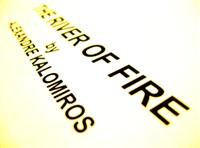
After the coming of the Holy Spirit at Pentecost, the growing Church “continued steadfastly in the Apostles’ doctrine and fellowship, in breaking of bread, and in prayers.” The uncompromising faith and unshakable courage that enabled Christ’s followers to boldly proclaim the divine message brought harsh persecution upon the young Church, beginning in Jerusalem. Stephen, a deacon who was known for his great faith and wisdom, became the Church’s first martyr. Those who stood by witnessing his killing laid their coats at the feet of a young man named Saul, a zealous enemy of the Church who consented to Stephen’s execution. Devout men carried Stephen’s lifeless body to its burial place and mourned for him, while Saul, determined to destroy the Church, persistently infiltrated the homes of believers, taking both men and women to prison.
Saul intended to expand his offensive against the Church to include the city of Damascus in Syria. He asked the Jewish high priest to write letters addressed to the synagogues in Damascus that would give him full authority to arrest any members of the Church he found there, both men and women, and bring them to Jerusalem. As Saul journeyed toward Damascus, a brilliant light shining down from heaven suddenly engulfed him. He fell to the ground and heard a voice say, “Saul, Saul, why are you persecuting me?” “Who are you, Lord?” he asked. The voice replied, “I am Jesus, whom you are persecuting.” To persecute the Church, the “body of Christ,” is to persecute Jesus Christ Himself.
Since Saul had been blinded by the heavenly light, his traveling companions led him into the city. Christ sent one of His faithful servants, Ananias, to heal him. Ananias said to Saul, “Brother Saul, the Lord, even Jesus, that appeared to you on the way here has sent me so that you might receive your sight and be filled with the Holy Spirit.” Saul immediately regained his sight and was baptized into the Church. Soon thereafter, Saul, also known as Paul, began fearlessly proclaiming the Gospel of Jesus Christ to the astonishment of all who had known his brutal reputation.
Stephen’s martyrdom prompted many believers to leave Jerusalem and move to Antioch, a major city in Syria near the Mediterranean Sea. According to tradition, St. Peter founded the church in Antioch in AD 34. As the message about Jesus spread in the city, both Jews and Gentiles (non-Jews) believed the Gospel and became disciples of Jesus. Paul and his fellow worker, Barnabas, spent a whole year with the church in Antioch teaching the people. Antioch is the place where the disciples of Jesus were first called “Christians.”
As the Christians in Antioch worshiped, prayed, and fasted, the Holy Spirit said to them, “Dedicate Barnabas and Saul to me for the work I have called them to do.” Paul and Barnabas were ordained and sent out from Antioch to take the Gospel of Jesus deep into the Roman world.
Over the next several years, Paul and his missionary companions traveled throughout the vast Roman Empire, including modern Israel, Lebanon, Syria, Cyprus, Turkey, Greece, and Italy. They proclaimed the Truth, established local churches, passed on the Faith handed down to them, and offered spiritual guidance to the new believers.
Empowered by the Holy Spirit, Christ’s Apostles, including Paul, continued to spread the Gospel throughout the known world during the first century. They faithfully remembered the instructions and promise Jesus had given them before His ascension into heaven:
All power is given to me in heaven and on earth. Go and teach all nations, baptizing them in the name of the Father, and of the Son, and of the Holy Spirit, teaching them to observe everything I have commanded you. And I am with you always, even to the end of the age.
Jesus had promised His disciples that His Church would endure, invincible. By ordination with the laying on of hands, the Holy Apostles upon whom Christ founded His Church passed on the Faith and authority they had received to the next generation of bishops (episkopoi). The bishops who succeeded the Holy Apostles continued to guard the Faith entrusted to them and to oversee the local churches. As the Church grew, the bishops needed help caring for the thriving Church. Bishops ordained presbyters (presbyteroi), also known as priests, granting them the authority to pastor the local churches and carry out the work of the Church on their behalf.
Church tradition affirms that Peter, before he left Antioch for Rome, appointed Euodius as his successor in the city. The early Church historian Eusebius reported that Ignatius, the second bishop of Antioch, was ordained as bishop in AD 69, only about 36 years after the Apostles witnessed the death, resurrection, and ascension of Christ, followed by the descent of the Holy Spirit at Pentecost. Bishop Ignatius experienced the consequences of persecution. Escorted by armed guards, he traveled to Rome for his execution. During the journey, Ignatius spent the last days of his life writing letters to several churches, including those in Ephesus, Philadelphia, Smyrna, and Rome. He also wrote a personal letter to his friend, Polycarp, bishop of Smyrna. When he arrived in the city of Rome he was martyred, torn apart by wild beasts.
Polycarp was a young man when the Romans killed Ignatius. According to Irenaeus, bishop of Lyons, Polycarp had been a disciple of the Apostle John and knew others who had seen Jesus when He walked upon the earth. Just before his own martyrdom, Bishop Polycarp was brought before a Roman proconsul for trial. The proconsul demanded, “Swear an oath and I will let you go - revile Christ!” Polycarp replied, “I have served Him eighty-six years and He has never done anything wrong to me, so how can I blaspheme my King who saved me?”
For many years after Pentecost, Christians endured persecution. Many suffered and died during the first three centuries of the Church. At the beginning of the fourth century, however, the life of the Church would change dramatically when Constantine the Great became emperor of the Roman Empire. Under Constantine’s rule, the Church transitioned from being a persecuted community to having official status within the empire. As the Church would later proclaim, the Empire that killed the Martyrs was conquered by their Faith. Emperor Constantine moved the capital of his empire from the city of Rome in the West to the city of Constantinople, the “New Rome,” in the East. This new Christian empire, now with an eastern orientation, became known in later times as the Byzantine Empire. Constantine declared the Christian Faith as the state religion, endowed the Church’s bishops with legal authority, and built glorious church buildings throughout the land. The Church would no longer need to hide from the authorities and worship in secret.
During the Byzantine Empire, the bishops of the Church from all over the world, many of whom bore the scars of severe persecution, joined together in Seven Ecumenical Councils to deal with pressing issues facing the Church. On matters of theology the Councils did not adopt new doctrine, but affirmed and defined the Orthodox Faith taught by the Holy Apostles and preserved by every succeeding generation of the Church since her beginning. The greatest accomplishments of the Councils include the formal recognition of certain early writings as Holy Scripture and the adoption of the Nicene Creed, a statement of faith summarizing the Orthodox Faith of the Christian Church:
We believe in one God, the Father Almighty, Maker of heaven and earth, and of
all things visible and invisible;
And in one Lord, Jesus Christ, the Son of God, the Only-begotten, Begotten of the Father before all ages, Light of Light, True God of True God, Begotten, not made, of one essence with the Father, by Whom all things were made:
Who for us men and for our salvation came down from heaven, and was incarnate of the Holy Spirit and the Virgin Mary, and was made man;
And was crucified also for us under Pontius Pilate, and suffered and was buried;
And the third day He rose again, according to the Scriptures;
And ascended into heaven, and sitteth at the right hand of the Father; And He shall come again with glory to judge the living and the dead, Whose kingdom shall have no end.
And we believe in the Holy Spirit, the Lord, and Giver of Life, Who proceedeth from the Father, Who with the Father and the Son together is worshipped and glorified, Who spoke by the Prophets;
And we believe in One, Holy, Catholic, and Apostolic Church. We acknowledge one Baptism for the remission of sins. We look for the Resurrection of the dead,
And the Life of the age to come. Amen.
Five major centers of Christianity, called Patriarchates, eventually emerged in the early Church: Rome, Constantinople, Alexandria, Antioch, and Jerusalem. Each bishop who served to shepherd one of these churches bore the title, “Patriarch.” Each Patriarch was responsible for the Christian churches within his particular geographic region. Although the Church was organized according to Patriarchates, the individual jurisdictions together constituted one body, the Church of Jesus Christ, the One Holy Catholic and Apostolic Church.
One of the most significant events in the history of the Church occurred a little over a thousand years after its founding. The Patriarch of Rome, who had been honored by his brother bishops as “the first among equals,” declared himself to be the supreme bishop over the whole Church. The Roman Patriarchate also decided to change the Nicene Creed, which had been formed, adopted, affirmed, and accepted by the whole Church. When the other four Patriarchates refused to accept Rome’s innovations, the Roman Patriarchate, the only Patriarchate in the western world, completed its break with the Church in the East and eventually became known as the Roman Catholic Church. The other four Patriarchates, remaining undivided and continuing to preserve the Faith, became known as the Orthodox Christian Church. (“Orthodox” means “right teaching” and “right worship.”) About 500 years after Rome withdrew itself from the Orthodox Church, many Christians in the West broke from the Roman Catholic Church, protesting Roman claims concerning the Pope and other theological ideas. Thousands of different churches have developed within the Protestant movement.
The Holy Orthodox Church founded by Jesus Christ upon His Holy Apostles remains alive in the world today as it has for two thousand years. The Patriarchates of Jerusalem, Antioch, Alexandria, and Constantinople still exist. As the Church has grown through the centuries, new jurisdictions have joined the ancient patriarchates. The Orthodox Christian Faith was brought to America from the Old World by devoted missionaries and hopeful immigrants who have established the Church firmly in the New World. Many jurisdictions of the Orthodox Church, including Antiochian, Greek, and Russian, are represented in America.
We are together the One Holy Catholic and Apostolic Church, the mystical body of Christ, and the living Temple of the Holy Spirit on earth. Let us continue living the Orthodox Faith, the spiritual way of life.
Copyright © 2006 by Dana S. Kees. Adapted from “The Spiritual Story of Our Human Race,” The Mystery of You: A Collection of Writings, Vol. 1, Copyright © 2004 by Dana S. Kees.
(The icon is from the Iconographics ColorWorks Library, Copyright © 2001 Theologic Systems, Theologic.com. Used by Permission.)
















